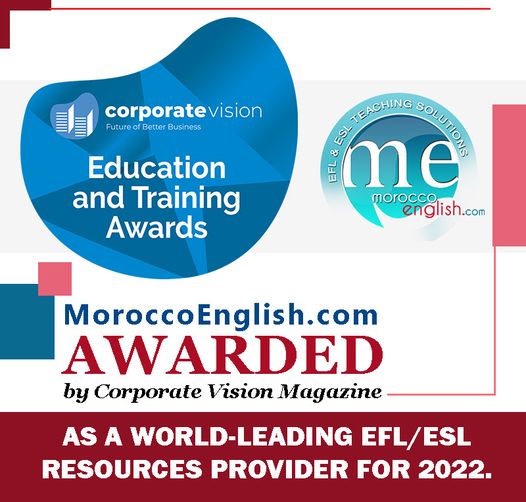
Written by : By : Mr Abdellah Sallo .
It has been noticed that schools adopt curricula that provide theoretical knowledge and abstract learning for students. In Morocco, any learner who has already got a certificate in any branch or any field lacks enough training and finds himself unable to guide social skills or a given profession. So educators and syllabus designers should think of what prepares the generations for the future careers. The textbooks and programs may modify the content and tasks to be taught as well as the techniques to apply in teaching.
It goes without saying that any language goes together with its culture. Those who learn foreign languages, learn not only their vocabulary items, grammatical structures, and functional expressions, but also learn how to communicate, how to behave, and how to interact. Therefore, teaching English, as a foreign language should be based on the 5Cs (communication, culture, comparison, connection, community), the topics and themes to be taught, and techniques to be used.
The 5Cs, standards for foreign language learning in 21st century (1999), reflect the themes linked to the world. They consist of 5 components. The first one is communication, so what is communication? The communication standard stresses the use of language for communication in “real life” situations. It emphasizes what students can do with language while they are interacting with others. Students are asked to communicate in oral and in written forms; interpret oral and written messages, show cultural understanding when they communicate, and present oral and written information to various audiences for a variety of purposes. Cultural understanding is an important part of the world languages education. Experiencing other cultures develops a better understanding and appreciation of the relationship between languages and other cultures, as well as the student’s native culture. Students become better able to understand other people’s points of view, ways of life, and contributions to the world.
World languages instruction must be connected with other subject areas like History and Geography, Philosophy, Science and Physics, and so on….. Content from theses subject areas is integrated with world language instruction through lessons that are developed around common themes. Students are encouraged to compare and contrast languages and cultures. They discover patterns, make predictions, and analyze similarities and differences across languages and cultures. Also students often come to understand their native language and culture better through such comparison.
Extending learning experiences from the world language classroom to be home and multilingual pus multicultural community. This learning emphasizes living in global society. Activities may include field trips, e-mail and the world clubs, exchange programs, and cultural activities to hear speakers of other languages in the classroom.
“Green Issues” have become the focus of school curriculum. The objective is to link school work with the world. Textbook rely too much on newspaper and magazine articles, TV news reports, documentary and feature films. So language teachers are concerned with the environmental themes as a means of linking the classroom to the world. In this context, teachers shouldn’t confine their concern of teaching grammar, vocabulary, and communication skills. Behind language, there are other things to teach, as educators we are very responsible to make our students aware of environmental issues like health problems, issues of medicines, education, deforestation, shopping, global warming, and cultural aspects. These kinds of issues are so pressing that they demand a response from the entire educational community. Environmental issues such as health problem, environment, education, are not only real, but they are of considerable interest and relevance to students. Learners in general are fascinated by the problems these issues present. Environmental themes can be linked to every subject in the curriculum, science, history, geography, mathematics, and arts… By using the environment as a theme, we can help bridge the gap between EFL and other school subjects (this is referred to as connection).
Environmental themes present numerous opportunities for project work and other activities which integrate the four skills. For example, students working in teams to do a “mini-research” project on countries with environmental problems get to practice reading, note taking, speaking, listening and writing. The most important techniques and strategies to teach these environmental themes are interpersonal and interpretive communications.
It’s obviously shown that class work consists of the following elements: Text knowledge + teacher’s knowledge + student’s knowledge. A teacher should never consider that a student is a blank sheet; s/he knows nothing about the target topic, but it’s an individual who has already acquired certain information from diverse sources. So the role of the teacher is to transmit and convey the knowledge that a text contains, taking into consideration the low level of the learner and the teacher has the ability to understand the knowledge treated by the given text. Any subject matter can be done in this way; the teaching learning operation is based on the process of these three elements of knowledge.
In teaching English, we rely on the 5Cs, as I have already referred to. One of these Cs is communication which consists of interpretive communication, interpersonal communication, and presentational communication. The Interpretive refers to Reading and Listening, interpersonal refers to dialogues interactions, functions. The last one is presentational which consists of peaking and writing.
Before presenting Reading or Listening the teacher has to begin with PRE-READING activity, or PRE-LISTENING activity in which students are involved in discussion and interaction about the given topic to see to what extent the learner knows about the topic, and to what extent can he get information from other subject matter. The pre reading or pre listening activities are made of various tasks: 1) Brainstorming : T. write the title on the BB, students guess and discuss the content of the text. 2) Discussing quotations related to the given topic; example: “Humor is an effective remedy” – students discuss the effect of humor 3) T. shows pictures or a picture reflecting the themes related to the txt to teach. T. and SS. discuss the vocabulary together. 4) Extracting the beginning and the ending of the text to be taught, the T. puts them on the BB, students try to the rest of the information. 5) Semantic maps, T. supplies a circle inside puts a word like “HUMOR” students find all the possible words linked to the word humor. 6) Oral sentences related to the topic, ss listen and respond T or F, they justify their answers to test their knowledge – the sentences should be linked to other subjects.
7) Matching and Building blocks, here the teacher encourages his students to speak an make sentences correctly: Teacher / games Student / exercises Children / activities So students are supposed to make any correct sentences adding other words from his repertoire.
8) T show picture of famous people like writers, inventors, stars, artists, singers, and so on. Let students say something about them, talk about them the compare what the text say 9) Use scanning and skimming to find information and answer questions, give reasons and make students read or listen to a passage. 10)T. puts a number of words on the BB, let students guess the content of the text using the context. The teacher may accept any topic without telling them, but at the end they can correct their answers after reading. The second phase T. passes to reading or listening. He should put two or three questions to guide students find their answers.
COMPREHENSION
There are two main levels of comprehension:
A) Understanding of the text B) Evaluation of the text
In A, the student deals with factual and liberal understanding which refers to linguistic knowledge, then s/he passes to the inferential understanding which consists of linguistic knowledge plus cultural knowledge. In B, the evaluation of the text, the student should work on critical and evaluative reading, which is analyzing what to read to form opinion. And, the appreciating reading which refers to the literary devices.
Tips for Teaching Large Classes
Large classes are often perceived as one of the major obstacles to ensuring quality education. Indeed, there are many research studies that point to the disadvantages of large classes and advocate small classes as a factor to ensure quality education. In spite of this, large classes are a reality in many schools and many countries, these classes contain about 40 to 45 students, often as a direct result of inadequate funding and the absence of political will provide a sufficient number of teachers and classrooms that would ensure an efficient education. This article attempts to present variety of practical methods and practices that would be useful for teachers who need to deal with a large class every day. It includes issues such as how to prepare and plan lessons specifically adapted for large classes. • Teachers are the sole most important factor in improving and answering the quality of education. • In a large class the teacher has to improve his organizational and managerial skills as he works to creatively organize his classroom into a comfortable, welcoming learning environment. • It’s an opportunity for a teacher to improve his interpersonal skills as he tries different ways to get to know each student as an individual through their work in class or their lives outside of it. They enjoy getting to know the teacher. • The value of a large class is that it contains a diversity of students and learning styles and the teacher can use many different, active, and funny ways of teaching. The cumulative knowledge, experiences, skills, and interests of students can be valuable starting points for planning lessons and activities so that learning becomes meaningful. • In a large class the teacher can give students assignments that ask them what they have learnt and what questions they have about what they have learnt, rather than following students’ failures, the teacher also track their successes.
PRACTICAL TIPS FOR TEACHING LARGE CLASSES
-
Building the Psycho-Social Environment
A classroom is often called a “learning community”. It’s that place within your school where you and your students can be found regularly, where everyone works together, teacher and students alike to learn new things about the world. So in a large class we should enjoy to create a sense of community, one that shows your interest in and accessibility to students and which encourages your students to learn about you and participate in the learning process. Creating this sense of community and its positive psycho-social environment can motivate your students to learn, get them involved, and help them to learn to their fullest, even under seemingly crowded conditions.
MAKE A LARGE CLASS FEEL SMALL
The teacher tries to make a large class small by treating it as such, s/he moves towards a student who has asked a question, which reduces physical and social distance, and s/he helps class assistance, distribute materials, encourage students to clean or write the date on the BB. Teachers should move around a lot, walking up and down the classroom.
KNOW YOUR STUDENTS’ NAME
Learning your students’ names is the first step in creating a comfortable classroom that will encourage student’s participation. It also shows students that are interested in them as individuals. Fortunately, there are many simple ways for learning students’ names and getting to know them .


































